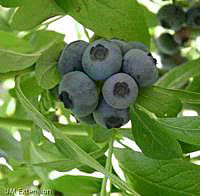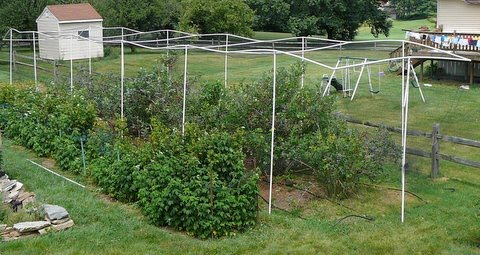Growing Blueberries
By Brad Willet, former Fairfax Master Gardener Blueberries have been a delight in the United States for thousands of years, and spring is a great time to plant young blueberry plants while soils are moist, and temperatures are mild. Many tribes of indigenous North American people recognized the quality of these edible fruits and shared their knowledge with many of the early European settlers and explorers, such as John Bartram, Meriwether Lewis, and Henry David Thoreau. Records as early as 1615 indicate uses and cultivation of wild blueberries and were likely enjoyed dried at the first Thanksgiving.
Blueberries have been a delight in the United States for thousands of years, and spring is a great time to plant young blueberry plants while soils are moist, and temperatures are mild. Many tribes of indigenous North American people recognized the quality of these edible fruits and shared their knowledge with many of the early European settlers and explorers, such as John Bartram, Meriwether Lewis, and Henry David Thoreau. Records as early as 1615 indicate uses and cultivation of wild blueberries and were likely enjoyed dried at the first Thanksgiving.
Wild harvested blueberries were sold in the 1840’s during the Civil War. In 1911, Elizabeth White, the daughter of a New Jersey cranberry farmer, teamed up with USDA botanist Frederick Coville to identify wild plants with the most desirable properties, crossbred them and began developing varieties of blueberries that could be grown on farms and in home gardens.
Growing from 2 feet to 12 feet (.5 to 4 m), depending on the variety, this native shrub is a great all-season plant. It provides food and great interest in its foliage and flowers. Pink and crimson buds in early spring evolve to dark green foliage as they mature through the growing season. A display of white bell-like flowers brighten up the planting area and attract a variety of bees, which are essential to achieve fruit set. The fruits set into small green juvenile berries that ripen from pink to red to deep blue in the summer. This shrub puts out a spectacular display of foliage in the fall that changes from green to oranges and deep crimson reds. Blueberry bushes work great as foundation plants, focal specimens or even as a natural hedge. These versatile plants are sure to be a joy for years to come.
 Members of the Ericaceae family that include plants adapted to acid soil (think azaleas and rhododendrons), there are more than 35 species of blueberries (Vaccinium) indigenous to North America. The best species supported by Virginia’s diverse climate are the lowbush (Vaccinium angustifolium), highbush (V. corymbosum) and rabbiteye (V. ashei). It’s a good idea to plant more than one cultivar within each species you select to provide an overlap in the bloom period for adequate cross pollination, allowing for a wider window of ripening fruits and a longer harvest. Many blueberries can be self-fertile, not requiring active pollination, but any time you allow the native pollinators to help out, the better it will be for the fruit set. Many native bees will visit your blueberry flowers, and the flowers need these visitors often to pollinate the flowers to achieve maximum berry growth.
Members of the Ericaceae family that include plants adapted to acid soil (think azaleas and rhododendrons), there are more than 35 species of blueberries (Vaccinium) indigenous to North America. The best species supported by Virginia’s diverse climate are the lowbush (Vaccinium angustifolium), highbush (V. corymbosum) and rabbiteye (V. ashei). It’s a good idea to plant more than one cultivar within each species you select to provide an overlap in the bloom period for adequate cross pollination, allowing for a wider window of ripening fruits and a longer harvest. Many blueberries can be self-fertile, not requiring active pollination, but any time you allow the native pollinators to help out, the better it will be for the fruit set. Many native bees will visit your blueberry flowers, and the flowers need these visitors often to pollinate the flowers to achieve maximum berry growth.
Site selection and preparation will ensure greater success with blueberries. They generally prefer well-draining soils, high in organic matter in full sun, but can tolerate some shade. They also need acidic soils around the pH of 4.3 to 5.3. Soil test results from your planting site will determine what amendments you will require to help your plants succeed. Soil amendments are generally recommended to be added the fall prior to planting. This can be done using soil additives such as sulfur, soil acidifiers or other amendments to bring down the pH to a minimum of 6 inches of soil depth.
Young blueberry bushes should be planted in April or early May. Blueberries have a shallow, fibrous root system and are sensitive to drying out, so planting holes should be dug no less than twice as wide as the blueberry’s root ball. A uniform and adequate supply of water is essential during their first season as they become established, about 1 inch (2.5 cm) of water per week. If this amount isn’t supplied by natural soil water or rainfall, you must irrigate. Check the soil frequently for adequate moisture and irrigate if necessary. Using a wood chip, pine bark or pine needle mulch will also help with soil moisture retention. Depending on how you want them to look at maturity, spacing each plant about 3 feet apart (1 m) is advisable, unless the variety you are planting will get larger.
And if your location is strapped for space — have no fear! Blueberries can also thrive in containers. They can be easier to protect from birds, less prone to disease, easier to harvest and easier to move if needed. Keep in mind they have the same soil and drainage needs as they would have in the ground. There are cultivars that have been bred especially for containers, which are usually a cross between V. corymbosum and V. angustifolium. They are sometimes called “patio blueberries,” and some cultivars will have pink berries as opposed to blue — but taste just as good.

Netting around bushes
Some things to consider: Blueberries need about three years to get established. Whether in your landscape or in a container, it is best to allow a blueberry bush to concentrate on acclimating to its new home and growing a great root structure. You’ll want to avoid letting it flower the first two years to help the plant grow stronger. Also, it is recommended to let your blueberry bush grow as it will for the first three years, with no need to prune during this time.
Blueberries are generally free from many issues or pests. The main pests will be the wildlife foraging on your berries before you do. Physical deterrents like netting will help to keep your harvest from being stolen until you are ready to pick your berries for yourself.
Blueberries are great plants not only by providing food for you, but they are gorgeous in the landscape. With the proper soil and planting conditions, you can enjoy these wonderful plants for years to come.
…updated 2025
- References
- Native Fruit: The Wild Blueberry, Julia Blakely, Smithsonian Libraries
- Manna In Winter: Indigenous Americans, Huckleberries, and Blueberries, Kim E. Hummer, Horticulture Science
- Growing Blueberries in Your Home Garden, EC1304, Oregon State Extension
- Specialty Crop Profile: Blueberries, 438-103, Virginia Cooperative Extension
- Fruits and Berries You Can Grow, Charlotte Glen, NC State Cooperative Extension
- Growing Blueberries in a Home Garden, University of Maryland extension